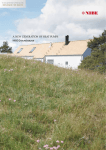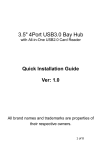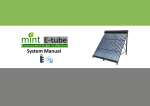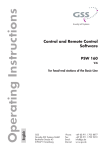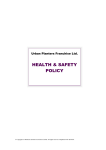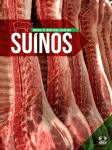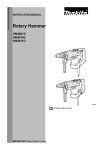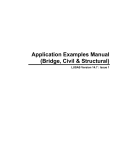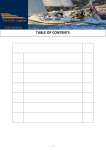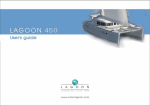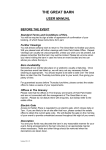Download ALL-RISK HOME INSURANCE Conditions Nr
Transcript
ALL-RISK HOME INSURANCE Conditions Nr. EE1E -1 APPROVED By “BTA Insurance Company” SE 10.06.2014 Board Decision No. LV1_0002/02-03-03-2014-84 Effective from 17.06.2014 TABLE OF CONTENTS Object of insurance ...................................................................................................................................... 1 Insured event .............................................................................................................................................. 2 Exclusions ................................................................................................................................................... 4 Insurable value and sum insured .................................................................................................................... 5 Safety requirements ...................................................................................................................................... 5 Insurance indemnity ...................................................................................................................................... 6 1. OBJECT OF INSURANCE Object of insurance 1.1. The object of insurance is a building, a part of a building, an apartment, apartment ownership, outbuilding, foundation (hereinafter referred to together as a building) or home property designated in the insurance contract, the insured risk of which is being insured. Building and its important parts 1.2. A building is a legal building permanently attached to the ground, which has a roof, exterior enclosure and interior spaces, including its important parts that are used for living. The important parts of a building are: 1.2.1. Construction elements (e.g. foundation, exterior walls, interior walls, inserted ceilings, roof constructions and covers of a building); 1.2.2. doors, gates, elevators, stairs, windows and their glasses; 1.2.3. inner and outer decoration; 1.2.4. water supply, systems of heating, drainage, electricity, security alarm and communications with all of the construction’s permanently attached elements (incl. sanitary ware, central heating boiler and radiators, hot water boilers, pumps, filters); 1.2.5. stoves, fireplaces, chimneys, fire safety installations; 1.2.6. permanently incorporated air conditioning, ventilation, floor heating and lighting devices; 1.2.7. built-in furniture and integrated kitchen appliances; 1.2.8. antennae, marquees, monitoring cameras and lighting equipment attached permanently to the building; 1.2.9. permanently incorporated exterior communication lines like gas, oil, heating, water and drainage pipelines and electric cables on the insurance location up to the boundary of immovable property, but no further than the accession points of the object of insurance. 1.2.10. other inseparable parts of the building construction. Part of a building 1.3. A part of a building (incl. semi-detached and terraced houses) which is delimited by construction and enables independent use; and its parts and important parts of a building belonging to it that have been mentioned in point 1.2. and do not belong to the physical share. A part of a building in common ownership is insured according to the extent of common ownership of the policy holder. (also in semidetached and terraced houses) Apartment 1.4. An apartment is a living space and its parts which are delimited by construction and enable independent use and can be modified without causing damage to parts of a building that are in common ownership of apartment owners. Insurance of an apartment incorporates its interior decoration, built-in furniture, integrated kitchen appliances, floor, ceiling, septum, sanitary ware, doors and windows, balcony and loggia, system parts of electricity, gas, heating, water supply, drainage, ventilation, air conditioning, fire extinction, communication and security alarm, on which only one apartment owner depends. The pantry belonging to the apartment is also included in the apartment insurance. Apartment ownership 1.5. With apartment is possible to insure apartment ownership. Apartment ownership is a living space and its parts, which are delimited by construction and enable 1|6 independent use, and building parts belonging to it that are in the common ownership of apartment owners and make up no physical share. A building in common ownership is an object of insurance in the extent of the common ownership belonging to the policyholder. The pantry belonging to the apartment is also included in the apartment ownership insurance. Auxiliary building 1.6. An auxiliary building is a separate non-residential building (e.g. sauna, garage, lairage, granary, shed). Improvement construction 1.7. An improvement construction is a construction that is not a building and has been permanently attached to the ground (e.g. boundary fence, shelter, wall, access road, footway, outdoor lighting, and flagpole) and locates on the same real estate as a building or a part of a building, if not stated otherwise in the insurance contract. Object of insurance is not 1.8. Unless agreed upon differently, an object of insurance is not: 1.8.1. buildings and constructions that are not meant for long-term use (portable mobile homes, tents, inflatable constructions, temporary constructions, etc.) and the home property that these include; 1.8.2. water constructions (e.g. ponds, fountains, pools, containers) that remain outside of the insured property; 1.8.3. pumps in water bodies and wells; 1.8.4. water or other liquids in the pipelines or pools of the object of insurance; 1.8.5. sculptures, sports grounds; 1.8.6. greenhouses; 1.8.7. bridges, berths, constructions under or on top of water; 1.8.8. a building or parts of a building, the construction of which has not been in accordance with the claims provided by law. Home property 1.9. Home property is movable property marked in the insurance contract and located in the area of insurance. 1.9.1. Depending on the choice of the policyholder, home property can be insured as a set of objects or as single objects. Area of insurance 1.9.2. An area of insurance includes a building, part of a building or an apartment that is located on the address provided in the insurance contract. An area of insurance also includes a pantry located in an apartment building, outside an apartment, used solely by the policyholder, e.g. a basement box. If not marked otherwise in the insurance contract, the area of insurance of home property does not include constructions and sheds, garages and other outbuildings belonging to the apartment building. Home property insured only on special agreement 1.9.3. If not marked otherwise in the insurance contract, home property does not include: 1.9.3.1. plants, animals; 1.9.3.2. Constructions that are not meant for long-term use (e.g. tents, sheds, inflatable constructions); 1.9.3.3. land vehicles, watercraft and aircraft with accessories; 1.9.3.4. building materials; 1.9.3.5. weapons, ammunition, explosives; 1.9.3.6. computer software, licences, electronic data, databases; 1.9.3.7. cash, securities, debt securities, documents, scripts, drawings, sketches, paintings, plans, card indices, payment cards and other means of payment; 1.9.3.8. jewels, precious metals and objects of precious metal, gemstones and semiprecious gemstones; 1.9.3.9. unique objects, prototypes and collections. According to the given conditions, a collection is a systematic collection of objects of the same type (e.g. postage stamps, postcards, calendars, labels, coins), which has a scientific, cultural-historical or art value. 2. INSURED EVENT Insured event 2.1. An insured event is the damage, destruction or loss of an object of insurance caused by an unexpected and unforeseen event, except in cases described under the given conditions in “Exclusions“ and under the general conditions of BTA insurance contracts in “General exclusions″. Supplementary insurance coverage 2.2. When signing the contract of insurance, the BTA and policyholder may agree upon supplementary insurance coverage: 2|6 of 2.2.1. Rental costs of temporary residence 2.2.1.1. If, in the case of an insured event, an insured property is destructed or damaged to the extent that it can be no longer used for dwelling, the insurer will compensate for the rental costs of temporary residence and the necessary moving costs in equal amount; 2.2.1.2. Rental costs of temporary residence are compensated on the basis of cost documents up to the restoration of an insured property or in full amount of the destructed property, but for no longer than 12 months after the insured event. Extension of the insurance area of home property 2.2.2. Extension of the insurance area of home property 2.2.2.1. Insurance coverage of home property of the policyholder or that of family members is valid in the territory of Estonia, if not provided otherwise in the insurance contract. 2.2.2.2. According to the given conditions, the husband or wife or life partner and their minor children or dependants are regarded as family members. 2.2.2.3. Insurance coverage is only valid if the home property is under supervision or in a closed room or place. Bicycles must be locked. 2.2.3. Key service The insurer will compensate for the costs of key service, incurred by lock pinch-off, replacement or repair, when the lawful owner of an insured residence cannot enter the room due to a lost or damaged key or locking system. The costs of key service are compensated on the basis of cost documents in the amount of the sum insured agreed upon. Rental costs temporary residence Family members Insurance coverage validation Key service Electricity risks 2.2.4. Electricity risks 2.2.4.1. The insurer will compensate for the damage caused to home property or devices of the building (e.g. heating boiler, hot water boiler, switchboard, elevators), if it is caused by: 1) power interruption due to an accident or without being notified of in advance; 2) the effect of electric current, incl. damage caused by excess voltage or short circuit; 3) indirect effect of lightning and electrical or magnetic phenomena that follow. 2.2.4.2. Damage caused by regular or informed power interruptions is not regarded as an insured event. Civil insurance 2.2.5. Civil Liability insurance Liability Insured person Co-insured person Third party The object Extended insurance insurance liability Insured event 2.2.5.1. Within the concept of civil liability insurance, the physical person whose liability is being insured is regarded as an Insured person. 2.2.5.2. Co-insured persons are Insured person’s wife or her husband or life partner, their minor children and dependents, also a person who uses the insured property according to the approval of the Insured person. Insured person and Co-insured person carries all the same responsibilities as the policyholder, which are provided in the insurance contract, excluding the responsibility of paying the insurance premium and his or her activity is regarded as an activity of the policyholder. 2.2.5.3. Third party is any person whose bodily injury or property has been damaged by unlawful activity. Policyholder, Insured person and Co-insured person and their direct relatives in terms of the Family Law Act are not regarded as a Third party. 2.2.5.4. The insurance object is general civil liability of the Insured person or the Coinsured person. Liability insurance provides insurance coverage as required by a Third party, when the Insured person or Co-insured person has caused or is responsible for the damage according to the law and the claim is causally connected to the possession of the property mentioned in the insurance contract. 2.2.6. Upon special agreement, extended civil liability insurance also provides an Insured person,- Insured person’s wife or her husband or life partner, their minor children and dependants, in addition to civil liability insurance, with insurance coverage in the territory of the Republic of Estonia in relation to all damage culpably caused to Third party, excluding the exclusions given in point 2.2.8. Extended civil liability insurance also includes the civil liability insurance coverage of pet owners. 2.2.7. If damage was done during the period of insurance and the claim was filed to the insurer within 1 year after the end of the insurance contract, it is regarded as an insured event. In the case of an insured event brought out in point 2.2.5.4. and 2.2.6., the insurer will compensate for the damage caused to a Third party by unlawful activity instead of the Insured person, and will bear the Insured persons costs of legal assistance. 3|6 Exclusions 2.2.8. There is no compensation for Civil Liability insurance and Extended Liability insurance: 2.2.8.1. Indirect damage; 2.2.8.2. Property owner’s liability is not insured in other properties which are not being insured by this insurance contract; 2.2.8.3. Contractual damage; 2.2.8.4. Damage caused by commercial activity; 2.2.8.5. Damage caused by works of construction, renovation or alteration; 2.2.8.6. Damage caused by using powered land vehicles, watercraft or aircraft; 2.2.8.7. Public promise to pay; 2.2.8.8. Damage arising from asbestos; 2.2.8.9. Claims related to the Liability for Damage Caused by Major Source of Danger, except claims related to the building and their parts and in case of Extended liability insurance - damage caused by a pet belonging to the insured person; 2.2.8.10. Damage caused by the insured person or Co-insured person when intoxicated by alcohol, narcotic substances or other toxic substances; 2.2.8.11. Non-material damage; 2.2.8.12. Damage that is compensated by the national social insurance budget according to the legislation of the Republic of Estonia, by paying pensions and grants, or by support provided by the national or local budget; 2.2.8.13. Damage caused by any kind of weapons; 2.2.8.14. Pollution or environmental damage; 2.2.8.15. Damage related to viruses, bacteria or infections; 2.2.8.16. Claims arising from damaging or loss of any type of object belonging to the insured or co-insured person or which had been placed under his/her care; Other additional insurance coverage 2.3. If the sides agree upon this, it is also possible to insure other risks that have not been provided or have been excluded in the given conditions. 3. EXCLUSIONS There is no compensation for 3.1. It is not regarded as an insured event and there is no compensation for loss, when the damage has been caused directly or indirectly under the following circumstances: Long-term processes 3.1.1. continuous long-term processes (e.g. corrosion, wear and tear, oxidation, lime scale, rotting, moulding, fungus damage, natural effect of humidity or light, change in colour, smell, dust, waste, soot, changes in air temperature or humidity level, drying, vaporisation, changes in material or exterior decoration); As an exception, damage is compensated for that has not been caused directly by the circumstances mentioned above (e.g. when a depreciated pipe falls apart and water damages the interior decoration of an insured property, the restoration costs of interior decoration receive compensation, but the repair costs of water pipes are not compensated for). Sinking and cracking 3.1.2. sinking, shifting and cracking of the foundation, when the mentioned processes are not caused by an insured event; 3.1.3. freezing of ground; 3.1.4. effect of chemicals; 3.1.5. weight of ice and snow; 3.1.6. damage caused by pests, rodents or other animals; Wrong use 3.1.7. violation of the user manual and conditions of the object of insurance or using the object of insurance for unintended purposes or ways; Construction related 3.1.8. performing renovation, reconstruction or construction works in the area of insurance, while ignoring the valid legislation; 3.1.9. low quality renovation, maintenance, designing work or using low quality or unsuitable material; Interruptions 3.1.10. interruptions of water, gas, electricity or any other energy supply, when such interruption is not caused by an insured event; 3.1.11. damaging or loss of computer files and software; Power interruptions 3.1.12. damage to electrical devices (e.g. heating boiler, hot water boiler, pump), which are caused by power interruptions (e.g. an accident or power outage), short 4|6 circuit or the indirect effect of lightning, if not agreed upon and mentioned otherwise in the policy; 3.1.13. changes in the level of groundwater and overflow of the drainage system and rainwater pipes; Asbestos 3.1.14. effect of asbestos and its ingredients; 3.1.15. flooding, if not agreed upon otherwise in the insurance contract; 3.1.16. erosion of soil, collapse, earth fall, earthquake that measures at least 4.0 on the Richter scale or a tsunami; 3.1.17. invasion of precipitation or melting water of ice or snow through the roof, constructions of the roof cover, windows, doors, joints, the foundation or other constructions; 3.1.18. accumulation of condensation; Loss of home property (excl. burglary and robbery) Manufacturer’s warranty 3.1.19. other reasons related to the loss of home property, excluding burglary and robbery. According to the given conditions, it is regarded as burglary when an insured building has been broken into by damaging its constructions or locks and when clear signs of burglary have been detected; and theft of property by using violence or threatening violence; is regarded as robbery 3.1.20. damage that must be compensated by the manufacturer or purveyor according to legislation or the contract (e.g. manufacturer’s warranty); 3.1.21. costs of regular maintenance or repairs, incl. the replacement of worn out parts; 3.1.22. damage of liquid and fume leakage that is causally related to the construction works performed on the object of insurance. 4. INSURABLE VALUE AND SUM INSURED Insurable value 4.1. Insurable value is the value of insurable interest during the insured event. The policyholder is obliged to notify the insurer of the correct insurable value. If it appears during the insured event that the insurable value differs from the value of the object of insurance, the principles of under-insurance and over-insurance will be used to calculate the insurance indemnities. Insurable value of building 4.2. Insurable value of a building is the restoration value, i.e. the minimum necessary costs of restoring the building in its original form. Insurable value of home property 4.3. The insurable value of home property that is not older than 52 years is the value of re-acquisition. Value of re-acquisition is the cost of purchasing an equal new item. The insurable value of another home property is the current value of an object, if the sides have not agreed upon otherwise. Current value is the price of an object of insurance on the local market, considering the age and physical depreciation of the object. Sum insured 4.4. Sum insured is the maximum payment sum for one insured event. 4.5. Sum insured is not decreased by the paid insurance indemnities. Insuring as a set 4.6. Home property makes an object of insurance a set in the extent of the sum insured, if not provided otherwise in the insurance contract. When insuring home property as a set of objects, the principle of under-insurance is not used. Insuring as single objects 4.7. When home property is insured as single object, every insured object and its insurable value is marked in the insurance contract. 4.8. If the insurable value of a single object of home property exceeds 2800 EUR, it will be insured as a single object. Otherwise the insurance indemnity of that object is not more than 2800 EUR for the insured event. 5. SAFETY REQUIREMENTS Policyholder responsibility Avoidance of freezing 5.1. The policyholder and family members are obliged to possess the insured property and use it with regular care and fulfil the safety requirements provided in the legislation and the insurance contract. 5.1.2. The policyholder must guarantee the working order of the water supply, drainage and heating system and close or empty the water supply, drainage or heating systems in non-used or non-heated buildings. In buildings where there is no heating 5|6 Closing a building Keeping of keys and codes Fire alarm Security alarm during the heating period or the air temperature falls under 0 °C, water must be flushed out from the water supply and heating systems in order to avoid freezing. 5.1.3. When leaving a building, its windows, hatches and other openings must be closed so that entering would be impossible without violating or removing the locks or barriers to the entrance. 5.1.4. Keys and codes of locks, and also keys and codes of a security alarm may not be kept in a place and way which enables access by third party persons. The name and address indicating the location of the insured object may not be written on the keys. When a key or code has been lost, the lock or code must be replaced immediately. 5.1.5. If a fire alarm has been installed in the insured area, it must be activated around the clock. The fire alarm must be designed, put together, installed, regulated and maintained according to the valid fire safety rules and manufacturer’s instructions. 5.1.6. If a security alarm has been installed in the insured area, it must be activated for the period when the insured area is left unattended. The operation area or sensitivity of the security alarm sensor may not be reduced without authorisation. 6. INSURANCE INDEMNITY Compensation for damage of a building 6.1. In the case of an insured event, the insurer will compensate for the costs that are necessary for restoring the building and bringing it back into the condition that prevailed before the insured event. Supplementary compensation for costs 6.2. The insurer will provide supplementary compensation for the costs of clearing up and demolishing property damaged as a result of an insured event and for taking away the garbage. Also, the insurer will provide compensation for the costs of preventing and/or reducing further damage. The maximum amount of the costs mentioned in the given point is up to 10% of the sum insured. Deductible 6.3. Deductibles will be discounted from the insurance indemnity. In the case of employing several deductibles simultaneously, the largest deductible will be discounted from the insurance indemnity. Under-insurance 6.4. In the case of under-insurance, insurance indemnity will be paid in proportion to the relation of the sum insured and the insurable value during the insured event. Over-insurance 6.5. In the case of over-insurance where the sum insured is larger than the insurable value, damages will be compensated in an amount equal to the value of the object of insurance. Initial compensation 6.6. In the case of a building, the insurer has the right to first compensate the part of for a building insurance indemnity which considers the depreciation of the building. The rest of it will be compensated on the basis of calculations concerning restoration of the building, if the policyholder is using the insurance indemnity in the same place to restore a building of the same kind and with the same purpose within two years from the beginning of compensation. The policyholder must have proved that the initial compensation has been used for restoring the same building. Compensation in the 6.7. If the object of insurance is in co-ownership and has not been divided into physical case of coshares, the costs caused by damage or destruction of an insured property in coownership ownership will be compensated in proportion to the part of co-ownership that is possessed by the insured person. Compensation of repairs 6.8. If the damaged property can be repaired and it is economically reasoned, the costs of repairs will be compensated. Financial compensation 6.9. If renovation of home property is impossible or economically unreasonable, financial compensation will be paid. Financial compensation is paid according to the principle that objects up to the age of 25 years are compensated at the price of a new object of the same kind; in the case of older objects, their current value or the price of a used object of the same kind is taken into account. Deposition of damaged objects to insurer 6.10. The insurer has the right to demand that the policyholder deposits the object of insurance (its parts) before paying the insurance indemnity. If the policyholder does not wish to deposit the damaged or destructed object (its parts), the insurer will compensate the difference in the value of the object of insurance before and after the insured event. 6|6







